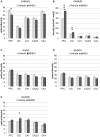Altered neuronal excitability underlies impaired hippocampal function in an animal model of psychosis
- PMID: 26042007
- PMCID: PMC4438226
- DOI: 10.3389/fnbeh.2015.00117
Altered neuronal excitability underlies impaired hippocampal function in an animal model of psychosis
Abstract
Psychosis is accompanied by severe attentional deficits, and impairments in associational-memory processing and sensory information processing that are ascribed to dysfunctions in prefrontal and hippocampal function. Disruptions of glutamatergic signaling may underlie these alterations: Antagonism of the N-methyl-D-aspartate receptor (NMDAR) results in similar molecular, cellular, cognitive and behavioral changes in rodents and/or humans as those that occur in psychosis, raising the question as to whether changes in glutamatergic transmission may be intrinsic to the pathophysiology of the disease. In an animal model of psychosis that comprises treatment with the irreversible NMDAR-antagonist, MK801, we explored the cellular mechanisms that may underlie hippocampal dysfunction in psychosis. MK801-treatment resulted in a profound loss of hippocampal LTP that was evident 4 weeks after treatment. Whereas neuronal expression of the immediate early gene, Arc, was enhanced in the hippocampus by spatial learning in controls, MK801-treated animals failed to show activity-dependent increases in Arc expression. By contrast, a significant increase in basal Arc expression in the absence of learning was evident compared to controls. Paired-pulse (PP) facilitation was increased at the 40 ms interval indicating that NMDAR and/or fast GABAergic-mediated neurotransmission was disrupted. In line with this, MK801-treatment resulted in a significant decrease in GABA(A), and increase in GABA(B)-receptor-expression in PFC, along with a significant increase of GABA(B)- and NMDAR-GluN2B expression in the dentate gyrus. NMDAR-GluN1 or GluN2A subunit expression was unchanged. These data suggest that in psychosis, deficits in hippocampus-dependent memory may be caused by a loss of hippocampal LTP that arises through enhanced hippocampal neuronal excitability, altered GluN2B and GABA receptor expression and an uncoupling of the hippocampus-prefrontal cortex circuitry.
Keywords: GABA; MK801; NMDA receptor hypofunction; hippocampus; in vivo; schizophrenia.
Figures







Similar articles
-
Long-lasting changes in hippocampal synaptic plasticity and cognition in an animal model of NMDA receptor dysfunction in psychosis.Neuropharmacology. 2013 Nov;74:48-58. doi: 10.1016/j.neuropharm.2013.01.001. Epub 2013 Jan 31. Neuropharmacology. 2013. PMID: 23376021 Review.
-
Changes in Neuronal Oscillations Accompany the Loss of Hippocampal LTP that Occurs in an Animal Model of Psychosis.Front Behav Neurosci. 2017 Mar 8;11:36. doi: 10.3389/fnbeh.2017.00036. eCollection 2017. Front Behav Neurosci. 2017. PMID: 28337131 Free PMC article.
-
Persistent deficits in hippocampal synaptic plasticity accompany losses of hippocampus-dependent memory in a rodent model of psychosis.Front Integr Neurosci. 2013 Mar 15;7:12. doi: 10.3389/fnint.2013.00012. eCollection 2013. Front Integr Neurosci. 2013. PMID: 23508474 Free PMC article.
-
Time-Dependent Alterations in the Expression of NMDA Receptor Subunits along the Dorsoventral Hippocampal Axis in an Animal Model of Nascent Psychosis.ACS Chem Neurosci. 2018 Sep 19;9(9):2241-2251. doi: 10.1021/acschemneuro.8b00017. Epub 2018 Apr 10. ACS Chem Neurosci. 2018. PMID: 29634239
-
Hippocampal NMDA receptors and the previous experience effect on memory.J Physiol Paris. 2014 Sep-Dec;108(4-6):263-9. doi: 10.1016/j.jphysparis.2014.08.001. Epub 2014 Aug 15. J Physiol Paris. 2014. PMID: 25132342 Review.
Cited by
-
Recapitulation and Reversal of Schizophrenia-Related Phenotypes in Setd1a-Deficient Mice.Neuron. 2019 Nov 6;104(3):471-487.e12. doi: 10.1016/j.neuron.2019.09.014. Epub 2019 Oct 9. Neuron. 2019. PMID: 31606247 Free PMC article.
-
Maladaptive Neuroplasticity Under Stress: Insights into Neuronal and Synaptic Changes in the Prefrontal Cortex.Mol Neurobiol. 2025 Jun 23. doi: 10.1007/s12035-025-05152-5. Online ahead of print. Mol Neurobiol. 2025. PMID: 40545507 Review.
-
Early Loss of Vision Results in Extensive Reorganization of Plasticity-Related Receptors and Alterations in Hippocampal Function That Extend Through Adulthood.Cereb Cortex. 2019 Feb 1;29(2):892-905. doi: 10.1093/cercor/bhy297. Cereb Cortex. 2019. PMID: 30535137 Free PMC article.
-
Distinct Time-Course of Alterations of Groups I and II Metabotropic Glutamate Receptor and GABAergic Receptor Expression Along the Dorsoventral Hippocampal Axis in an Animal Model of Psychosis.Front Behav Neurosci. 2019 May 8;13:98. doi: 10.3389/fnbeh.2019.00098. eCollection 2019. Front Behav Neurosci. 2019. PMID: 31139061 Free PMC article.
-
Functional Compartmentalization of the Contribution of Hippocampal Subfields to Context-Dependent Extinction Learning.Front Behav Neurosci. 2019 Nov 14;13:256. doi: 10.3389/fnbeh.2019.00256. eCollection 2019. Front Behav Neurosci. 2019. PMID: 31798429 Free PMC article.
References
-
- Álvarez-Jiménez M., Gleeson J. F., Henry L. P., Harrigan S. M., Harris M. G., Killackey E., et al. . (2012). Road to full recovery, longitudinal relationship between symptomatic remission and psychosocial recovery in first-episode psychosis over 7.5 years. Psychol. Med. 42, 595–606. 10.1017/s0033291711001504 - DOI - PubMed
LinkOut - more resources
Full Text Sources
Other Literature Sources
Miscellaneous

